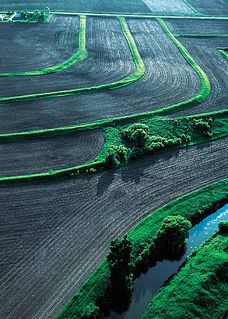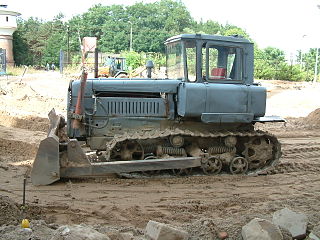 W
WEarthworks are engineering works created through the processing of parts of the earth's surface involving quantities of soil or unformed rock.
 W
WAnthroposols are soils which have been profoundly modified or constructed by humans. They typically have one or more of their natural soil horizons modified, removed or replaced. The word anthroposol is derived from the Greek words anthropos, meaning man and genes meaning caused. Anthroposols are typically found on industrial, commercial, urban and resources extraction sites as well as throughout transportation, fuel and power corridors.
 W
WCrushed stone or angular rock is a form of construction aggregate, typically produced by mining a suitable rock deposit and breaking the removed rock down to the desired size using crushers. It is distinct from gravel which is produced by natural processes of weathering and erosion, and typically has a more rounded shape.
 W
WDecomposed granite is classification of rock that is derived from granite via its weathering to the point that the parent material readily fractures into smaller pieces of weaker rock. Further weathering yields material that easily crumbles into mixtures of gravel-sized particles known as grus, that further may break down to produce a mixture of clay and silica sand or silt particles. Different specific granite types have differing propensities to weather, and so differing likelihoods of producing decomposed granite. It has practical uses that include its incorporation into paving and driveway materials, residential gardening materials in arid environments, as well as various types of walkways and heavy-use paths in parks. Different colors of decomposed granite are available, deriving from the natural range of granite colors from different quarry sources, and admixture of other natural and synthetic materials can extend the range of decomposed granite properties.
 W
WAn earth structure is a building or other structure made largely from soil. Since soil is a widely available material, it has been used in construction since prehistoric times. It may be combined with other materials, compressed and/or baked to add strength. Soil is still an economical material for many applications, and may have low environmental impact both during and after construction.
 W
WHeavy equipment or heavy machinery refers to heavy-duty vehicles, specially designed for executing construction tasks, most frequently ones involving earthwork operations or other large construction tasks. Heavy equipment usually comprises five equipment systems: implementation, traction, structure, power train, control and information.
 W
WErosion control is the practice of preventing or controlling wind or water erosion in agriculture, land development, coastal areas, river banks and construction. Effective erosion controls handle surface runoff and are important techniques in preventing water pollution, soil loss, wildlife habitat loss and human property loss.
 W
WLightweight expanded clay aggregate (LECA) or expanded clay (exclay) is a lightweight aggregate made by heating clay to around 1,200 °C (2,190 °F) in a rotary kiln. The yielding gases expand the clay by thousands of small bubbles forming during heating producing a honeycomb structure. LECA has an approximately round or potato shape due to circular movement in the kiln and is available in different sizes and densities. LECA is used to make lightweight concrete products and other uses.
 W
WA fiber roll is a temporary erosion control and sediment control device used on construction sites to protect water quality in nearby streams, rivers, lakes and seas from sediment erosion. It is made of straw, coconut fiber or similar material formed into a tubular roll.
 W
WThe Groasis Waterboxx is a device designed to help in growing trees in dry areas. It was invented and developed by Dutch former flower exporter Pieter Hoff, and won the Popular Science Green Tech Best of What’s New Innovation of the year award for 2010. The word "Groasis" is a neologism formed as a portmanteau of the words "grow" and "oasis".
 W
WLand development is altering the landscape in any number of ways such as:Changing landforms from a natural or semi-natural state for a purpose such as agriculture or housing Subdividing real estate into lots, typically for the purpose of building homes Real estate development or changing its purpose, for example by converting an unused factory complex into condominium.
 W
WRiprap, also known as rip rap, rip-rap, shot rock, rock armour or rubble, is human-placed rock or other material used to protect shoreline structures against scour and water, wave, or ice erosion. Ripraps are used to armor shorelines, streambeds, bridge abutments, foundational infrastructure supports and other shoreline structures against erosion. Common rock types used include granite and modular concrete blocks. Rubble from building and paving demolition is sometimes used, as well as specifically designed structures called tetrapods.
 W
WA sand fence or sandbreak, similar to a snow fence, is a barrier used to force windblown, drifting sand to accumulate in a desired place. Sand fences are employed to control erosion, help sand dune stabilization, keep sand off roadways, and to recruit new material in desert areas. Sand fences are also commonly employed following storm events in order to aid in the dune recovery process, particularly in developed areas where dunes are critical for protection of property.
 W
WA sediment control is a practice or device designed to keep eroded soil on a construction site, so that it does not wash off and cause water pollution to a nearby stream, river, lake, or sea. Sediment controls are usually employed together with erosion controls, which are designed to prevent or minimize erosion and thus reduce the need for sediment controls. Sediment controls are generally designed to be temporary measures, however, some can be used for storm water management purposes.
 W
WA silt fence, sometimes (misleadingly) called a "filter fence," is a temporary sediment control device used on construction sites to protect water quality in nearby streams, rivers, lakes and seas from sediment in stormwater runoff. Silt fences are widely used on construction sites in North America and elsewhere, due to their low cost and simple design. However, their effectiveness in controlling sediment can be limited, due to problems with poor installation, proper placement, and/or inadequate maintenance.
 W
WIn geotechnical engineering, soil compaction is the process in which stress applied to a soil causes densification as air is displaced from the pores between the soil grains. When stress is applied that causes densification due to water being displaced from between the soil grains, then consolidation, not compaction, has occurred. Normally, compaction is the result of heavy machinery compressing the soil, but it can also occur due to the passage of, for example, animal feet.
 W
WA tunnel is an underground passageway, dug through the surrounding soil/earth/rock and enclosed except for entrance and exit, commonly at each end. A pipeline is not a tunnel, though some recent tunnels have used immersed tube construction techniques rather than traditional tunnel boring methods.
 W
WVibro stone columns or aggregate piers are an array of crushed stone pillars placed with a vibrating tool into the soil below a proposed structure. This method of ground improvement is also called vibro replacement. Such techniques increase the load bearing capacity and drainage of the soil while reducing settlement and liquefaction potential. Stone columns are made across the area to be improved in a triangular or rectangular grid pattern. They have been used in Europe since the 1950s, and in the United States since the 1970s. Column depth depends on local soil strata, and usually penetrates weak soil.